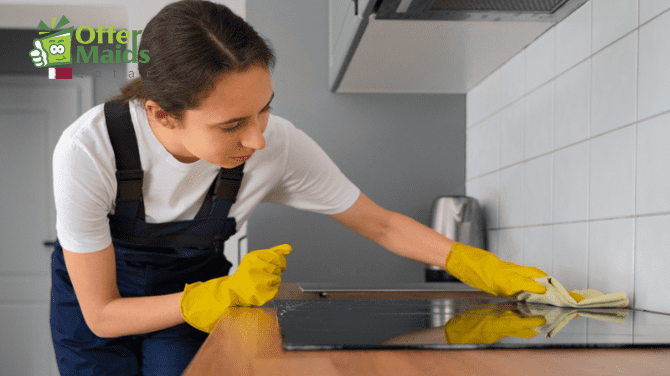
The kitchen is often the heart of the home, where meals are prepared, and families gather. However, it can also be a hotspot for germs and bacteria if not properly maintained. Keeping your kitchen clean and germ-free is crucial for a healthy home environment. Here’s how you can effectively reduce germs in your kitchen.
Clean and Disinfect Surfaces Regularly
Regular cleaning and disinfecting of kitchen surfaces are essential to reduce germs. Countertops, cutting boards, and other frequently touched areas should be cleaned daily.
Use a disinfectant cleaner or a solution of bleach and water: Mix one tablespoon of bleach with one gallon of water. Wipe down surfaces thoroughly with this solution.
Don’t forget handles and knobs: Frequently touched areas like refrigerator handles, microwave buttons, and cabinet knobs can harbor germs. Clean these spots regularly.
Practice Good Hand Hygiene
Good hand hygiene is one of the most effective ways to prevent the spread of germs in the kitchen.
Wash your hands before and after handling food: Use soap and warm water, scrubbing for at least 20 seconds.
Use hand sanitizer: Keep a bottle of hand sanitizer near the kitchen sink for quick clean-ups when soap and water aren’t available.
Proper Food Storage
Proper food storage helps prevent the growth of harmful bacteria.
Refrigerate perishable foods promptly: Ensure your refrigerator is set at 40°F (4°C) or below.
Store raw meats properly: Keep raw meat, poultry, and seafood in sealed containers on the lowest shelf to prevent juices from contaminating other foods.
Use airtight containers: Store leftovers in airtight containers and label them with the date to ensure they are used within a safe timeframe.
Keep the Sink and Drains Clean
The kitchen sink and drains can be breeding grounds for bacteria if not cleaned regularly.
Clean your sink daily: Use a disinfectant cleaner to wipe down the sink, including the faucet handles.
Boiling water down the drain: Pour boiling water down the drain once a week to kill germs and prevent buildup.
Sanitize Sponges and Dishcloths
Sponges and dishcloths can harbor a significant amount of bacteria.
Sanitize sponges: Microwave sponges on high for one minute or soak them in a bleach solution. Replace them regularly.
Use disposable paper towels: For tasks like cleaning up raw meat juices, consider using disposable paper towels to avoid cross-contamination.
Clean Appliances Regularly
Kitchen appliances need regular cleaning to reduce germs.
Wipe down appliances: Clean the interior and exterior of appliances like refrigerators, microwaves, and ovens with a disinfectant cleaner.
Clean handles and buttons: These areas are frequently touched and should be cleaned regularly.
Maintain a Clean Garbage Area
The area around your kitchen garbage can be a germ hotspot.
Clean the garbage can: Regularly clean the inside and outside of your garbage can with a disinfectant cleaner.
Use garbage bags: Line your garbage can with bags and replace them frequently to prevent leaks and odors.
Manage compost waste: Keep a small bin for compostable waste and empty it daily to prevent fruit flies and bacterial growth.
Use Food Thermometers
Cooking food to the right temperature is crucial for killing harmful bacteria.
Check food temperatures: Use a food thermometer to ensure meats, poultry, and seafood are cooked to safe internal temperatures. Refer to food safety guidelines for specific temperature recommendations.
Clean your thermometer: Wash your food thermometer with hot, soapy water before and after each use to prevent cross-contamination.
Avoid Cross-Contamination
Preventing cross-contamination is key to maintaining a germ-free kitchen.
Separate raw and cooked foods: Use separate cutting boards and utensils for raw and cooked foods. Wash your hands, utensils, and surfaces thoroughly after handling raw foods.
Color-code your kitchen tools: Consider using color-coded cutting boards and utensils to easily distinguish between those used for raw meat and those used for other foods.
Ventilate Your Kitchen
Proper ventilation helps reduce moisture and odors, making it harder for germs to thrive.
Use an exhaust fan: Turn on your kitchen exhaust fan while cooking to improve air circulation and reduce humidity.
Clean exhaust filters: Regularly clean the filters on your kitchen exhaust fan to maintain efficient airflow and remove grease buildup.
Conclusion
By following these practical steps, you can significantly reduce germs in your kitchen, ensuring it remains a clean and healthy space for food preparation and family gatherings. Regular cleaning, proper food storage, good hand hygiene, and preventing cross-contamination are essential practices. Make these habits part of your daily routine to keep your kitchen safe and inviting for everyone.

